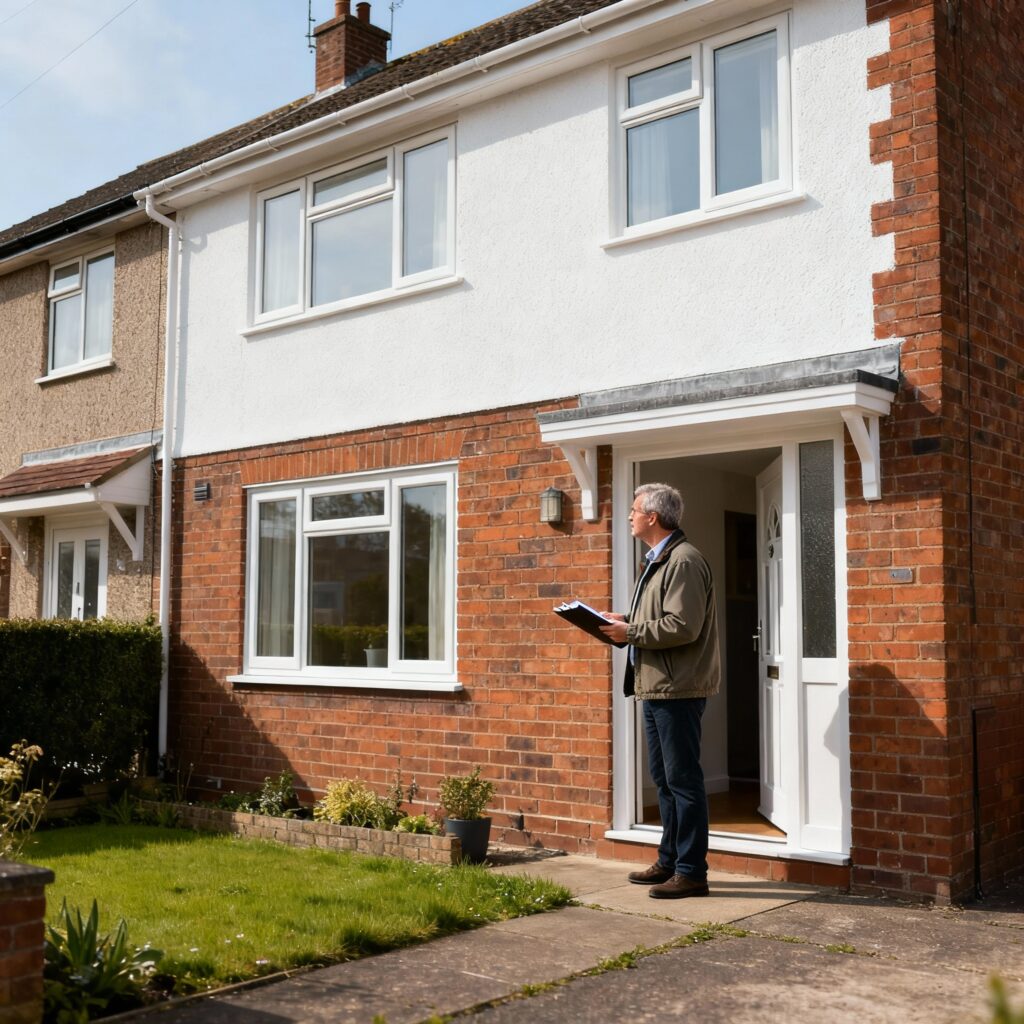Essential guide to inspection frequency, legal requirements, and practical tips for UK landlords to protect your rental investment.
Key takeaways
- Property inspections are vital to protect your buy-to-let investment and meet UK legal responsibilities.
- No law specifies the maximum number of inspections per year, but you must always give at least 24 hours’ written notice and respect tenants’ right to quiet enjoyment.
- Most UK landlords inspect every three to six months, with an initial check six to eight weeks into a new tenancy.
- More frequent visits may be necessary for HMOs, high-risk properties, or where prior issues are suspected.
- Regular inspections help spot maintenance issues early and prevent costly future repairs.
- Inspections assist in meeting insurance policy terms, avoiding cover being voided by missed checks.
- Annual gas safety checks and five-yearly electrical checks are mandatory requirements.
- Always document inspections with written reports and photographs for deposit and insurance evidence.
- Approach inspections professionally, give proper notice, and respect tenant privacy to prevent disputes or legal action.
- Building good communication and positive landlord-tenant relationships makes for smoother and more productive inspections.

Introduction
Property inspections play a crucial role for UK landlords aiming to keep rental homes safe, legal, and profitable. Inspections allow you to catch small problems before they escalate, encourage responsible tenant behaviour, and fulfil the obligations set by UK statute and your insurer. In this guide, you’ll learn exactly when, why, and how to inspect your property, what UK law says, and how frequent visits can protect your investment.
Below you’ll find straightforward guidance about inspection schedules, legal requirements, best practices, and key benefits for landlords. To keep your buy-to-let portfolio compliant and profitable, take advantage of our data-rich tables, practical tips, and trusted UK resources.
Understanding your legal rights for property inspections
As a UK landlord, you’re entitled to inspect your rental property for repairs and good order, but this comes with clear rules. The Landlord and Tenant Act 1985 grants you the right to access your property for checking repairs, providing “reasonable notice” – typically at least 24 hours in writing, unless there’s an emergency.
Inspections must be at a reasonable time and not so frequent as to breach tenants’ “quiet enjoyment” of the home. While there’s no statutory cap on the number of inspections, excessive or unscheduled visits could be regarded as harassment. Failing to follow the notice rules can lead to complaints or legal challenges, so always put arrangements in writing and respect the tenant’s space.
| Legal requirement | Details |
|---|---|
| Written notice | 24+ hours’ notice (often via email or letter) |
| Reasonable hours | Generally 9am–6pm, weekdays |
| Emergencies | No notice required |
| Legal basis | Landlord and Tenant Act 1985, Housing Act 1988 |
| Tenant refusal | Tenants can refuse entry except in emergencies |
Recommended frequency for property inspections
The “right” inspection interval depends on tenant type, property risk, and length of occupancy. Here’s a breakdown of the industry best practice in the UK:
- New tenancies: One initial inspection after six to eight weeks to check on property condition and address teething issues.
- Standard practice: Most landlords inspect every three to six months for most homes, which is generally regarded as reasonable by letting agents and professional bodies.
- Long-term, reliable tenants: For tenants with an excellent track record, once or twice annually might be sufficient to avoid appearing intrusive.
- High-risk properties or HMOs: Every one to three months – especially if there’s repeated damage, prior disputes, or shared accommodation with unrelated tenants.
| Tenancy scenario | Inspection frequency |
|---|---|
| New tenancy | 6–8 weeks after move-in |
| First year | Every 3–4 months |
| Long-term tenants | 6–12 months |
| HMO / risk properties | 1–3 months |
| Pre-leave inspection | 2–4 weeks before checkout |

What to check during property inspections
A compliant inspection covers more than a quick walk-through. Create a standard checklist that ensures you cover:
- Property exterior: roof, brickwork, gutters and drains, security lights
- Signs of damp, leaks or condensation
- Smoke and carbon monoxide alarm function
- Cleanliness, tenant care, and unauthorised subletting
- Safety issues (trip hazards, gas smell, loose handrails)
- Evidence of breaches: smoking, pets, or redecoration without consent
Photographic records and maintenance follow-ups are essential, both as evidence and to keep your repair log up to date.
| Area | What to check |
|---|---|
| Roof/exterior | Tiles, drains, damp, external doors |
| Kitchen and bathroom | Leaks, mould, extraction fans, working appliances |
| Living/bedroom | Damp, fixtures and fittings, fire escape routes |
| Alarms & legal checks | Smoke/CO alarms tested, fire doors if HMO |
| General upkeep | Cleanliness, excessive clutter, evidence of pets/smoking/unlawful sublets |
How inspections protect your investment and save money
Catching issues early can save you thousands in future repair costs. For example, identifying and fixing a minor roof leak or damp patch during a routine inspection can prevent long-term water ingress and serious structural problems. Prompt fixes also show tenants you care about home maintenance, encouraging them to act responsibly between inspections.
Regular checks are also essential for valid landlord insurance – many policies require evidence of recurring professional inspections (often every 3–6 months), or risk voiding cover over accidental damage or tenant neglect claims. All findings, photos, and tenant communications should be stored for at least six years for your own legal and tax records.
Managing tenant relationships during inspections
Communication is key: always set expectations about inspection frequency in your tenancy agreement. Provide ample notice and confirm visits in writing. Flexibility around the tenant’s work or family routine goes a long way to maintain goodwill.
Carry out inspections in a professional, non-intrusive manner—focus on the property, not personal belongings. After inspection, share a brief report (and any action plan for repairs) so tenants feel involved and respected. This keeps relations positive, encourages issue reporting, and safeguards tenancy renewals.
Mandatory safety checks (gas, electrical, alarms)
Some inspections are non-negotiable under UK law:
- Annual gas safety check: Required for all rental homes with gas, performed by a Gas Safe engineer; certificate provided to tenants before moving in and renewed yearly.
- Electrical safety (EICR): Full inspection and report by a qualified engineer at least every five years, or on change of tenancy.
- Smoke/CO alarm tests: Legally required functioning alarms on all storeys; carbon monoxide alarms wherever there is a solid fuel appliance (oil, wood, but not just gas boilers). Test on move-in and each inspection.
| Certificate/type | Required frequency | Who must inspect |
|---|---|---|
| Gas Safety | Every 12 months | Gas Safe engineer |
| EICR (electrical) | Every 5 years | Qualified electrician |
| Smoke/CO alarm | Start of tenancy, and each inspection | Landlord/agent |
Documenting inspections and creating reports
Robust documentation is your best defence against disputes and claims. Use a standardised template or trusted checklist provider for each inspection, ticking off each area and noting observations, repairs, and follow-up action. Take clear, timestamped photographs whenever you identify an issue (or prove good condition).
Keep all records, dated reports, and tenant acknowledgements for at least six years. This is vital evidence for:
- Deposit disputes
- Tenant damage claims
- Insurance claims
- Tenancy renewal negotiations
Common mistakes and how to avoid them
- Too few inspections: Annual checks are rarely enough and could trigger insurance exclusions.
- Too frequent/intrusive inspections: Visiting monthly without cause or consent can breach the “quiet enjoyment” rule and sour relations.
- No written notice: Always send at least 24 hours’ notice in writing; never “drop by.”
- Poor records: Failing to document findings, issues, and tenant correspondence can undermine deposit and insurance claims.
- Neglecting follow-up: Repairs must be arranged promptly after inspection findings to satisfy Section 11 of the Landlord and Tenant Act and insurance checks.
| Mistake | Consequence |
|---|---|
| No/few inspections | Missed problems, voided insurance, unhappy tenants |
| Excessive visits | Legal risk, tenant harassment, loss of goodwill |
| Poor documentation | Weak case in disputes, possible loss of deposit claims |
| Ignoring repairs | Fines, claims under Section 11, declining property value |
Frequently asked questions
How often can a landlord legally inspect in the UK? Most carry out checks every 3–6 months; more often may breach “quiet enjoyment”, less may fall short for insurance or maintenance.
Can tenants refuse entry for inspections? Yes, except in emergencies. A tenant may legally refuse access despite 24-hour notice; persistent refusal can usually be resolved by negotiation and written reminders.
Is there a minimum legal requirement? No, but insurance rarely covers let properties with no evidence of 6–12 monthly inspections, and legal gas and electrical checks are mandatory.
What happens if I don’t inspect regularly? You risk missed repairs, insurance claim denials, and losing evidence in deposit disputes or legal claims.
Who can do the inspection? Either the landlord, a letting agent, or a representative; for gas/electric safety, you need a registered professional.
Are HMOs different? Yes—quarterly or even monthly inspections are best practice; councils may impose tighter schedules in licences.
How do I give legal notice? Email or letter is adequate. State the date/time and purpose, and cite the relevant tenancy agreement clause for access.
How do inspections protect my insurance cover? Most policies require proof of regular checks; missed inspections can mean claims for damage or neglect are refused.




